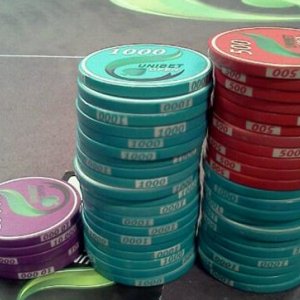Set Mining in No Limit Hold'em Tournaments

 There are 169 starting hands in No Limit Texas Hold’em. One group in particular causes more confusion and frustration than any other, small pairs (2-2, 3-3, 4-4, 5-5, and 6-6). “What’s the right way to play small pairs” is a question that has crossed many a poker player’s lips. While there is no easy answer, there are some guidelines that can greatly aid your decision-making process.
There are 169 starting hands in No Limit Texas Hold’em. One group in particular causes more confusion and frustration than any other, small pairs (2-2, 3-3, 4-4, 5-5, and 6-6). “What’s the right way to play small pairs” is a question that has crossed many a poker player’s lips. While there is no easy answer, there are some guidelines that can greatly aid your decision-making process.
Though many times any pair is the best hand pre-flop, most often one, if not more, over-cards appear on the flop, making the situation difficult to negotiate. Typically, you must fold your hand when facing resistance.
Small pairs have the most value when you are lucky enough to hit a set. Sets are very powerful hands that can have massive value because of their hidden nature. Unfortunately, hitting a set is the easy part of the equation, as you still have to get paid off enough chips to validate your pre-flop investment. The odds of hitting a set are about 7.5:1 when you see a flop with a pair.
Because they happen so infrequently, it is imperative to be able to extract the most value from your sets when you do hit them. So what are the conditions needed to make your set mining opportunities the most profitable?
As a general rule, I like a 20:1 as a ratio for set mining. For example, you are on the button with 5,000 in chips and the big blind is 100. Your opponent with 5,000 in chips raises to 2.5 times the big blind, or 250. You are getting 20:1 against his stack by calling since 5,000/250 = 20. However, this is not an entirely rigid rule, as you can adjust this number up and down given your particular read on your opposition.
For example, if you have witnessed several multi-street bluffs from one opponent in particular, you could call with the intent of set mining while only getting 15:1. If on the other hand you know your opposition well enough to know they will only go broke with a strong hand (for example, top pair, top kicker or an over-pair), you could easily adjust your set mining odds to 25:1.
With this in mind, let’s take a look at some ways to achieve our goals as they pertain to playing small pairs pre-flop with the idea of getting the most value when hitting a set.
Should I raise or should I call? If our objective is to see the flop as cheaply as possible, what is the best way to go about this? In general, I prefer to just call. For example, imagine a scenario in which the blinds are 25/50 early in our favorite PokerStars tournament. We are dealt pocket fours in early position and raise to 150 in chips (3x BB).
This would be just fine and dandy if we only get called; however if another player decides to re-raise to 450 in chips (3x our raise) and we only have 3,000 chips, it would be 250 to call, which doesn’t give us the right odds to get paid off profitably on our set mining attempt. You would then be forced to throw the hand away or make an unprofitable call.
On the other hand, if we were to limp and just call the big blind (50) and then get 3bet to 200 (4x BB) we can profitably call with the intention of playing a big pot. Since it will only be 150 more to call, which gives us approximately 20:1 odds with the starting stacks of 3,000, this is clearly a profitable situation.
In fact, we are hoping that our opponent has the strongest hand possible and won’t be able to fold, thus making it the most profitable situation in No Limit Hold’em, cracking aces or kings, particularly in low buy-in tournaments where the opposition is unable to fold over-pairs on the flop.
More to come! You can weigh in on your set mining odds by leaving a comment here.





